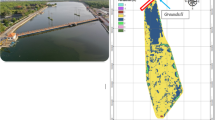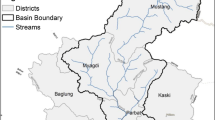Abstract
River plays an important role in the human need as it provides water for human usage, irrigation, agriculture and industry as well as a range of other ecosystem services other than intrinsic and biodiversity values. Managing the river can lead to many benefits and convenience. However, due to lack of proper management, rivers can be easily polluted due to human activities. Sediment is one of the components that can damage the ecosystem and diversity of the river especially in local spots which involves soil erosion. Heavy rainstorms can cause an excessive erosion event, however, most soil erosion happens gradually over time and is very hard to notice without constant monitoring. Furthermore, the sediment will be mobilized and transported along the river and eventually stored in the bottom of the river, but usually it will deposit near the estuary. A sediment modeling is needed to carter this problem as to predict the behavior of the sediment based on the hydrological components. The comparison between the 1D (HEC-RAS) and 3D (GETFLOWS) will be discussed in this paper to check the suitability and the validity of the model in sediment studies.
Access this chapter
Tax calculation will be finalised at checkout
Purchases are for personal use only
Similar content being viewed by others
References
Ding, L., Chen, K.L., Cheng, S.G., Wang, X.: Water ecological carrying capacity of urban lakes in the context of rapid urbanization: a case study of East Lake in Wuhan. Physics and Chemistry of the Earth, Parts A/B/C 89–90, 104–113 (2015)
Reitsma, K.D., Dunn, B.H., Mishra, U., Clay, S.A., DeSuttere, T., Clay, D.E.: Land-use change impact on soil sustainability in a climate and vegetation transition zone. Agronomy Journal. 10(6) (2015). https://doi.org/10.2134/agronj15.0152
Yusof, M.F., Jamil, N.R., Leaw, C.N.I., Aini, N., Manaf, A.L.: Land use change and soil loss risk assessment by using geographical information system (GIS): a case study of lower part of Perak River. IOP Conf. Ser.: Earth Environ. Sci. 37, 012065 (2016). https://doi.org/10.1088/1755-1315/37/1/012065
Bagarello, V., Di Stefano, C., Ferro, V., Pampalone, V.: Predicting maximum annual values of event soil loss by USLE-type models. CATENA 155, 10–19 (2017)
Ouyang, W., Wu, Y., Hao, Z., Zhang, Q., Bu, Q., Gao, X.: Combined impacts of land use and soil property changes on soil erosion in a mollisol area under long-term agricultural development. Sci. Total Environ. 613–614, 798–809 (2018)
Kitamura, A., Kurikami, H., Sakuma, K., Malins, A., Okumura, M., Machida, M., Mori, K., Tada, K., Tawara, Y., Kobayashi, T., Yoshida, T., Tosaka, H.: Redistribution and export of contaminated sediment within eastern Fukushima Prefecture due to typhoon flooding. In: Earth Surface Processes and Landforms. Wiley Online Library (2016)
Brunner, G.W., Gibson, S.: Sediment transport modelling in HEC RAS. Impacts of Global Climate Change (2005)
Joshi, N., Lamichhane, G.J., Rahaman, M.M., Kalra, A., Ahmad, S.: Application of HEC-RAS to study the sediment transport characteristics of Maumee River in Ohio. World Environmental and Water Resources Congress (2019). https://doi.org/10.1061/978084482353.024
Osuagwu, J.C., Nwachukwu, A.N., Nwoke, H.U., Agbo, K.C.: Effect of soil erosion and sediment deposition on surface water quality: case study of Otamiri River. Asian Journal Engineering and Technology (2014)
Li, H., Lin, L., Ye, S., Li, H., Fan, J.: Assessment of nutrient and heavy metal contamination in the sea water and sediment of Yalujiang Estuary. Mar. Pollut. Bull. (2017). https://doi.org/10.1016/j.marpolbul.2017.01.069
Liu, J.Q., Yin, P., Chen, B., Gao, F., Song, H.Y., Li, M.N.: Distribution and contamination assessment of heavy metals in surface sediments of the Luanhe River Estuary, northwest of the Bohai Sea. Mar. Pollut. Bull. 109, 633–639 (2016)
Lotze, H.K., Lenihan, H.S., Bourque, B.J., Bradbury, R.H., Cooke, R.G., Kay, M.C., et al.: Depletion, degradation, and recovery potential of estuaries and coastal seas. Science 312, 1806–1809 (2006)
Liu, R.M., Men, C., Liu, Y.Y., Yu, W.W., Xu, F., Shen, Z.Y.: Spatial distribution and pollution evaluation of heavy metals in Yangtze estuary sediment. Mar. Pollut. Bull. 110, 564–571 (2016)
Hume, A.D., Herdendorf, C.E.: A geomorphic classification of estuaries and its application to coastal resource management. Journal of Ocean and Shoreline Management. 11, 249–274 (1988)
Townend, I., Zhou, Z., Guo, L., Coco, G.: A morphological investigation of marine transgression in Estuaries. Earth. Surf. Processes. Land. 46(5) (2020)
Dalrymple, R.W.: Incised valleys in time and space: an introduction to the volume and an examination of the controls on valley formation. Society for Sedimentary Geology 5–14 (2006)
Rees, J.G., Ridgway, J., Ellis, S., Knox, R.W.O., Newsham, R., Parkes, A.: Holocene sediment storage in the Humber Estuary. Geological Society, London, Special Publications 166, 119–143 (2000)
Church, M.: Channel morphology and typology. In: The River Handbook, pp. 126–143. Blackwell Scientific Publishers, Oxford (1992)
Gilbert, J.T., Wilcox, A.C.: Sediment routing and floodplain exchange (SeRFE): A spatially explicit model of sediment balance and connectivity through river networks. Journal of Advance in Modelling Earth Systems (2020). https://doi.org/10.1029/2020MS002048
Wohl, E., Bledsoe, B.P., Jacobson, R.B., Poff, N.L., Rathburn, S.L., Walters, D.M., Wilcox, A.C.: The natural sediment regime in rivers: broadening the foundation for ecosystem management. Bioscience 65(4) (2015). https://doi.org/10.1093/biosci/biv002
Frings, R.M., Doring, R., Beckhausen, C., Schuutrumpf, H., Vollmer, S.: Fluvial sediment budget of a modern, restrained river: the lower reach of the Rhine in Germany (2014)
Maldegem, D.C., Mulder, H.P.J., Langerak, A.: A cohesive sediment balance for the Scheldt estuary. Netherlands Journal of Aquatic Ecology 27(2–4), 247–256 (1993)
Hazart, A.,Mori, K., Tada, K.,Tosaka, H.: Using surrogate modelling for fast estimation of water budget component in a regional watershed. In: International Congress on Environmental Modelling and Software. 7th International Congress on Environmental Modelling and Software, San Diego, USA (2014)
Hosono T., Yamada C., Shibata T.: Coseismic groundwater drawdown along crustal ruptures during the 2016 Mw 7.0 Kumamoto Earthquake. Lawrence Berkeley National Laboratory (2019)
Mori, K., Tada, K., Tawara, Y., Ohno, K., Asami, M., Kosaka, K., Tosaka, H.: Integrated watershed modelling for simulation of spatiotemporal redistribution of post-fallout radionuclides: application in radiocesium fate and transport processes derived from the Fukushima accidents. Environ. Model. Softw. 72, 126–146 (2015)
Rahman, S.A.T.M., Hosono, T., Tawara, Y., Fukuoka, Y., Hazart, A., Shimada, J.: Multiple-tracers-aided surface-subsurface hydrological modeling for detailed characterization of regional catchment water dynamics in Kumamoto area, southern Japan. Hydrogeol. J. 29, 1885–1904 (2021)
Sakuma K., Malins A., Funaki H., Kurikami H., Niizato T., Nakanishi T., Mori K., Tada K., Kobayashi T., Kitamura A., Hosomi M.: Evaluation of Sediment and 137Cs Redistribution in the Oginosawa River Catchment near the Fukushima Dai-ichi Nuclear Power Plant Using Integrated Watershed Modelling (2018)
Sakuma K., Kitamura A., Malins A., Kurikami H., Machida M., Mori K., Tada K., Kobayashi T., Tawara Y., Tosaka H.: Characteristics of radio-cesium transport and discharge between different basins near to the Fukushima Dai-ichi Nuclear Power Plant after heavy rainfall events (2017)
Amir, H.H., Ehsan, Z.: Evaluation of HEC-RAS ability in erosion and sediment transport forecasting. World Appl. Sci. J. 17(11), 1490–1497 (2012)
Hasani, H.: Determination of flood plain zoning in Zarigol river using the hydraulic model of HEC-RAS. International Research Journal of Applied and Basic Sciences (2013)
Thakur, B., Parajuli, R., Kalra, A., Ahmad, S., Gupta, R.: Coupling HEC-RAS and HECHMS in precipitation runoff modelling and evaluating flood plain inundation map. World Environmental and Water Resources Congress 2017, 240–251 (2017)
Foti, G., Barbaro, G., Manti, A., Foti, P., Torre, A.L., Geria, P.F., Puntorieri, P., Tramontana, N.: A methodology to evaluate the effects of river sediment withdrawal: the case study of the Amendolea River in southern Italy. Aquat. Ecosyst. Health Manage. 23(4), 465–473 (2020). https://doi.org/10.1080/14634988.2020.1807248
Horritt, M., Bates, P.: Evaluation of 1D and 2D numerical models for predicting river flood inundation. J. Hydrol. 268(1–4), 87–99 (2002)
Panin, N., Jipa, D.: Danube River sediment input and its interaction with the northwestern Black Sea. Estuar. Coast. Shelf Sci. 54(3), 551–562 (2019)
Werner, M.: Impact of grid size in GIS based flood extent map** using a 1D flow model. Phys. Chem. Earth Part B 26(7–8), 517–522 (2001)
Kitamura, A., Kurikami, H., Sakuma, K., Malins, A., Okumura, M., Machida, M., Mori, K., Tada, K., Tawara, Y., Kobayashi, T., Yoshida, T., Tosaka, H.: Redistribution and export of contaminated sediment within eastern Fukushima prefecture due to typhoon flooding. Earth Surf. Proc. Land. (2016). https://doi.org/10.1002/esp.3944
Mori, K., Tawara, Y., Hazart, A., Tada, K., Tosaka, H.: Simulating Nitrogen Long-term fate and transport processes at a regional scale with a surface and subsurface fully-coupled watershed model. In: 21st International Congress on Modelling and Simulation, Gold Coast, Australia (2015)
Jacks, G.V., Whyte, R.O.: The rape of the earth: a world survey of soil erosion. Rape. Earth. World. Survey. Soil. Erosion. (1939)
Hassan, M.A., Roberge, L., Church, M., More, M., Donner, S.D., Leach, J., Ali, K.F.: What are the contemporary sources of sediment in the Mississippi River? Geophys. Res. Lett. 44, 8919–8924 (2017)
Borelli, P., Robinson, D.A., Panagos, P., Lugato, E., Yang, J.E., Alewell, C., Wuepper, D., Montanarella, L., Ballabio, C.: Land use and climate change impacts on global soil erosion by water (2015–2070). Proc. Nat. Acad. Sci. 117(34), 1–8 (2020)
Ouillon, S.: Why and how do we study sediment transport? Focus on coastal zones and ongoing methods. Water 10(4), 390 (2018)
Yamamoto, S., Kumagai, M., Koga, K., Sato, S.: Mechanical stability of engineered barriers in a subsurface disposal facility during gas migration based on coupled hydromechanical modelling. Geol. Soc. Lon. Spec. Publ. 415(1) (2015)
Robert, W.C.J., Karen, F., William, J.: Auto-integrating multiple HEC-RAS flood-line models into catchment-wide SWMM flood forecasting models. AWRA Hydrol. Watershed. Manage. Tech. Committee 10(1), 1–15 (2012)
Traore, V.B., Bop, M., Faye, M., Giovani, M.: Using of HEC-RAS model for hydraulic analysis of a river with agriculture vocation: a case study of the Kayanga River Basin, Senegal. Am. J. Water. Res. 3(5), 147–154 (2015)
Acknowledgements
This study is in collaboration and financially supported by National Water Research Institute of Malaysia (NAHRIM) (Grant no. 304.PAWAM.6050432.l136).
Author information
Authors and Affiliations
Corresponding author
Editor information
Editors and Affiliations
Rights and permissions
Copyright information
© 2024 The Author(s), under exclusive license to Springer Nature Singapore Pte Ltd.
About this paper
Cite this paper
Abu Bakar, S.N. et al. (2024). Application of GETFLOWS and HEC-RAS in Assessing Sediment Balance Within River Estuary. In: Sabtu, N. (eds) Proceedings of AWAM International Conference on Civil Engineering 2022 - Volume 3. AICCE 2022. Lecture Notes in Civil Engineering, vol 386. Springer, Singapore. https://doi.org/10.1007/978-981-99-6026-2_46
Download citation
DOI: https://doi.org/10.1007/978-981-99-6026-2_46
Published:
Publisher Name: Springer, Singapore
Print ISBN: 978-981-99-6025-5
Online ISBN: 978-981-99-6026-2
eBook Packages: EngineeringEngineering (R0)




